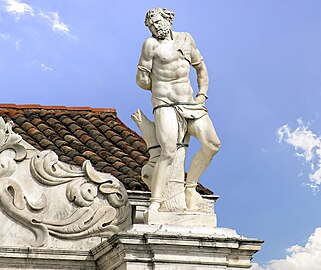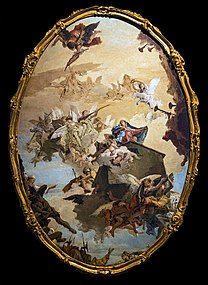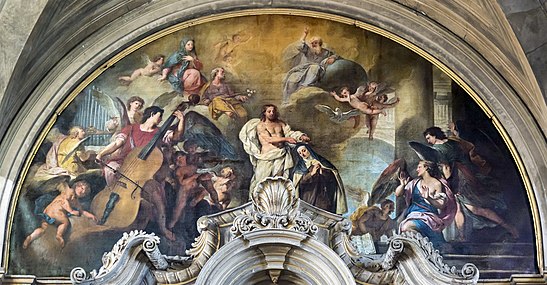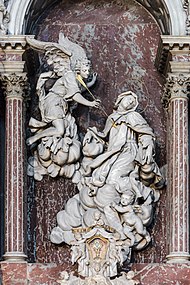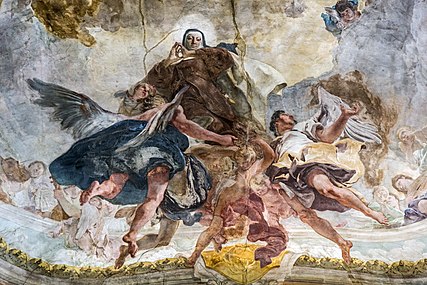
Giovanni Battista Tiepolo, also known as GiambattistaTiepolo, was an Italian painter and printmaker from the Republic of Venice who painted in the Rococo style, considered an important member of the 18th-century Venetian school. He was prolific, and worked not only in Italy, but also in Germany and Spain.

The Grand Canal is the largest channel in Venice, Italy, forming one of the major water-traffic corridors in the city.

The Basilica di Santa Maria Gloriosa dei Frari, commonly abbreviated to the Frari, is a church located in the Campo dei Frari at the heart of the San Polo district of Venice, Italy. It is the largest church in the city and it has the status of a minor basilica. The church is dedicated to the Assumption of Mary.

The Basilica dei Santi Giovanni e Paolo, known in Venetian as San Zanipolo, is a Catholic minor basilica and Dominican conventual church in the Castello sestiere of Venice, Italy.

Ca' Rezzonico is a palazzo and art museum on the Grand Canal in the Dorsoduro sestiere of Venice, Italy. It is a particularly notable example of the 18th century Venetian baroque and rococo architecture and interior decoration, and displays paintings by the leading Venetian painters of the period, including Francesco Guardi and Giambattista Tiepolo. It is a public museum dedicated to 18th-century Venice and one of the 11 venues managed by the Fondazione Musei Civici di Venezia.

Andrea Pozzo was an Italian Jesuit brother, Baroque painter, architect, decorator, stage designer, and art theoretician.

Sebastiano Ricci was an Italian Baroque painter of the late Baroque period in Venetian painting. About the same age as Piazzetta, and an elder contemporary of Tiepolo, he represents a late version of the vigorous and luminous Cortonesque style of grand manner fresco painting.

The Basilica of Saint Nicholas of Tolentino is a Roman Catholic church and minor basilica that is part of the Augustinian monastery in the hill-town of Tolentino, province of Macerata, Marche, central Italy. The church is a former cathedral of the Roman Catholic Diocese of Tolentino, suppressed in 1586.

San Stae is a church in central Venice, in the sestiere of Santa Croce.

Santa Maria del Rosario, commonly known as I Gesuati, is an 18th-century Dominican church in the Sestiere of Dorsoduro, on the Giudecca canal in Venice, northern Italy. The classical style building has a well-lit interior and is exceptional in preserving its original layout and Rococo decoration intact. The church and almost all its sculpture and paintings were created within a thirty-year period: construction began in 1725, the church was consecrated in 1743, and the last sculptural decoration was in place by 1755.

San Francesco della Vigna is a Roman Catholic church in the Sestiere of Castello in Venice, northern Italy.

Santa Maria dei Carmini, also called Santa Maria del Carmelo and commonly known simply as the Carmini, is a large Roman Catholic church in the sestiere, or neighbourhood, of Dorsoduro in Venice, northern Italy. It nestles against the former Scuola Grande di Santa Maria del Carmelo, also known as the Scuola dei Carmini. This charitable confraternity was officially founded in 1597, and arose from a lay women's charitable association, the Pinzocchere dei Carmini. The members of this lay group were associated as tertiaries to the neighbouring Carmelite monastery. They were responsible for stitching the scapulars for the Carmelites.
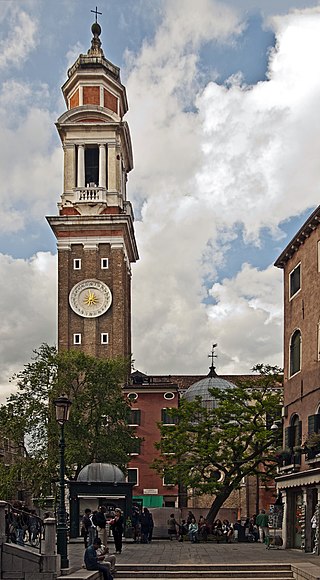
The Chiesa dei Santi Apostoli di Cristo, commonly called San Apostoli, is a 7th-century Roman Catholic church located in the Cannaregio sestiere of the Italian city of Venice. It is one of the oldest churches in the city and has undergone numerous changes since its foundation. The present building is the result of a major reconstruction project which was undertaken in 1575. The church is notable particularly for the Cornaro Chapel, an important example of Early Renaissance architecture, added by Mauro Codussi during the 1490s. The chapel is the burial place of several members of the powerful Cornaro family, including Catherine Cornaro, Queen of Cyprus and Armenia. The church houses several works of art including pieces by Giambattista Tiepolo and Paolo Veronese.

The Church of San Marco in San Girolamo is a baroque parish church in Vicenza, northern Italy, built in the 18th century by the Discalced Carmelites. It houses various artworks by artists of the early 18th century from Veneto. The sacristy preserves its original furniture of the same period.

The church of Santa Maria Assunta, known as I Gesuiti, is a religious building in Venice, Italy. It is located in the sestiere of Cannaregio, in Campo dei Gesuiti, not far from the Fondamenta Nuove.

The Scuola Grande dei Carmini is a confraternity building in Venice, Italy. It is located in the sestiere of Dorsoduro, before Campo dei Carmini and Campo Santa Margherita, upon which its facade looks. It stands, separated by an alley, to the northeast of the church of Santa Maria dei Carmini.

The church of Santa Maria della Pietà or della Visitazione is a prominent church in the sestiere of Castello in Venice, Italy. It is sited on the Riva degli Schiavoni, a short walk from the Doge's Palace.
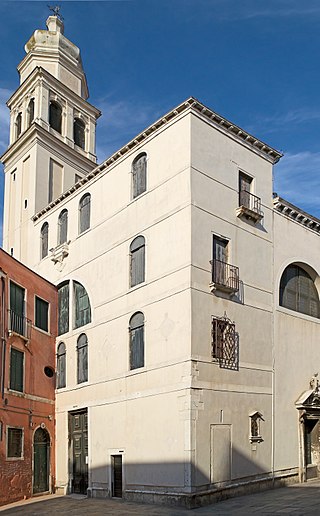
Sant'Antonin is a church in the sestiere of Castello in Venice, Italy.

The Church of Saint Teresa of Ávila is a Baroque-style church located on Via Santa Teresa, near Piazza San Carlo in Turin, Italy.



